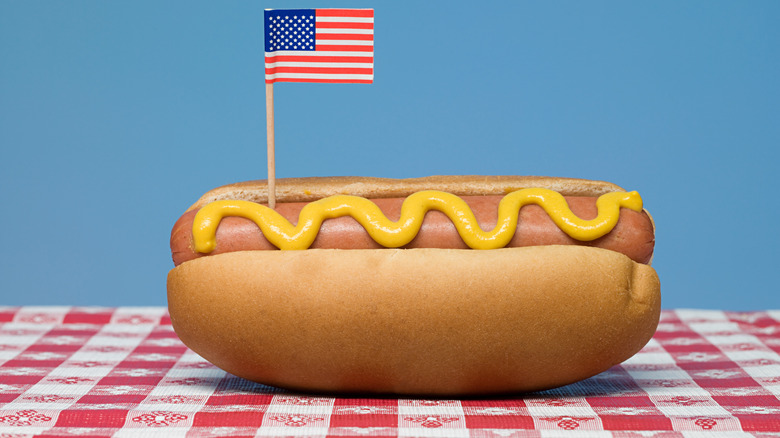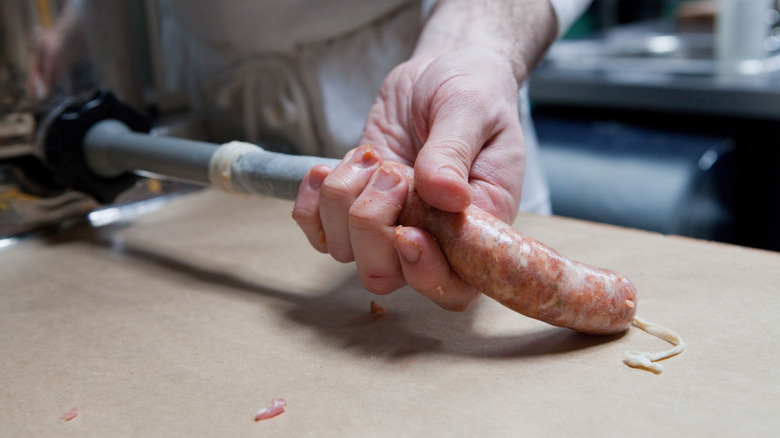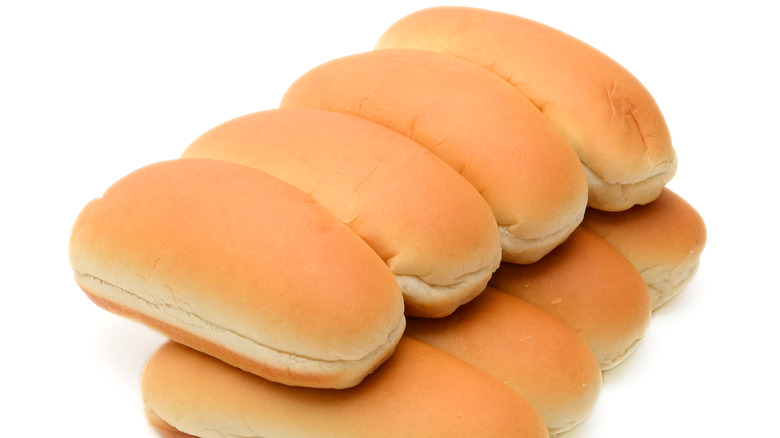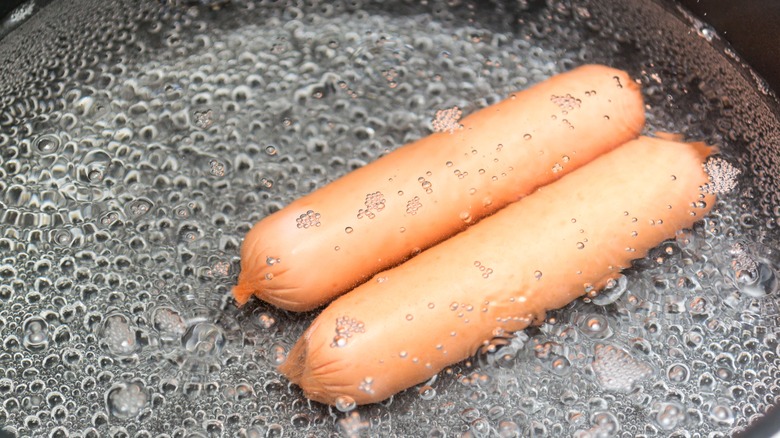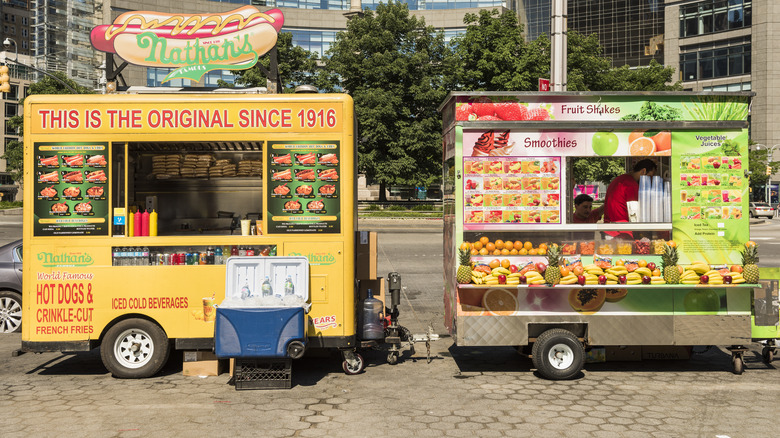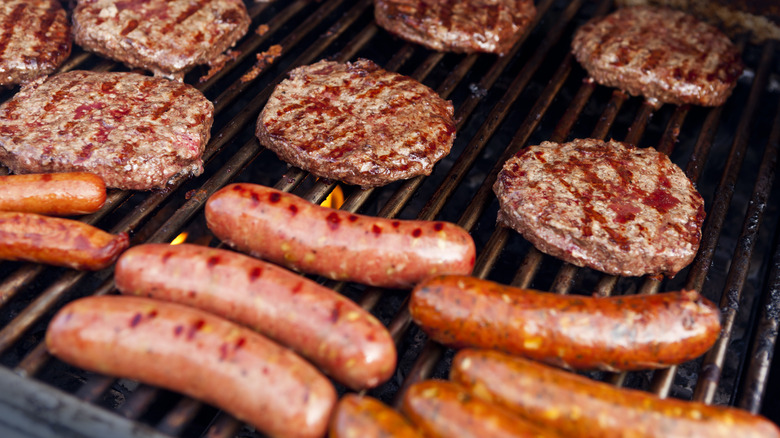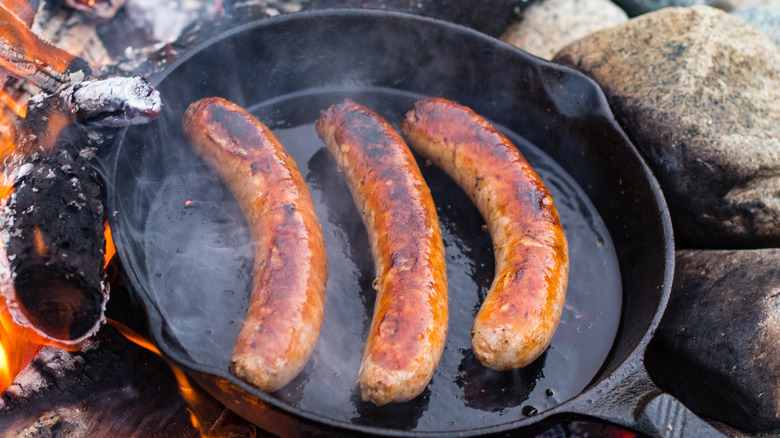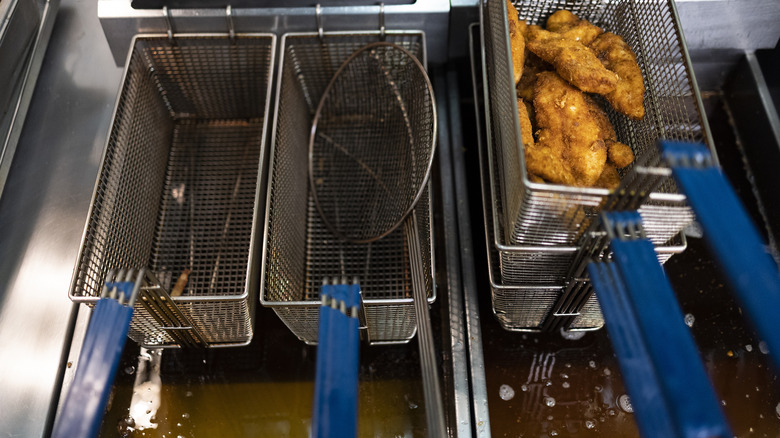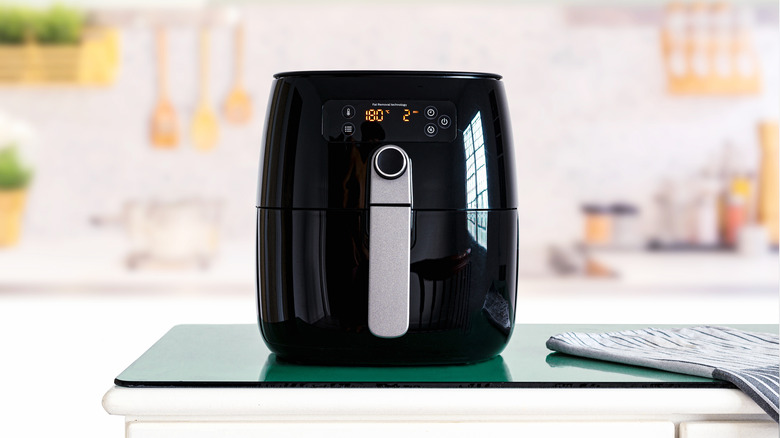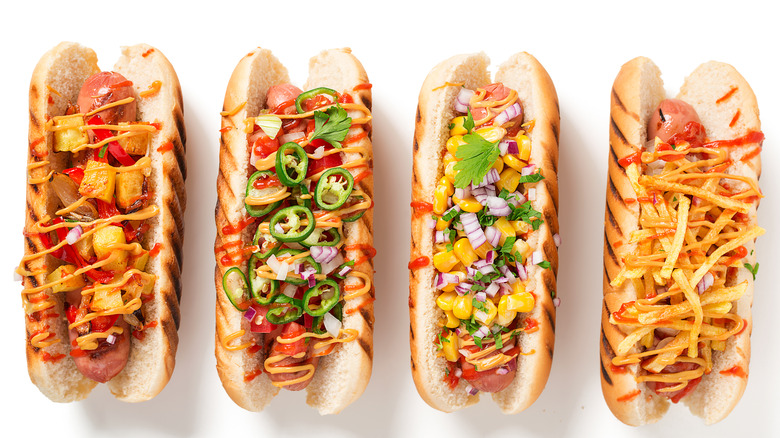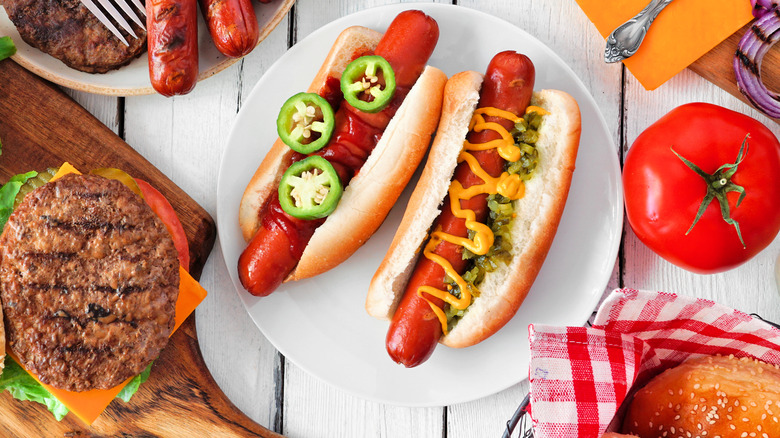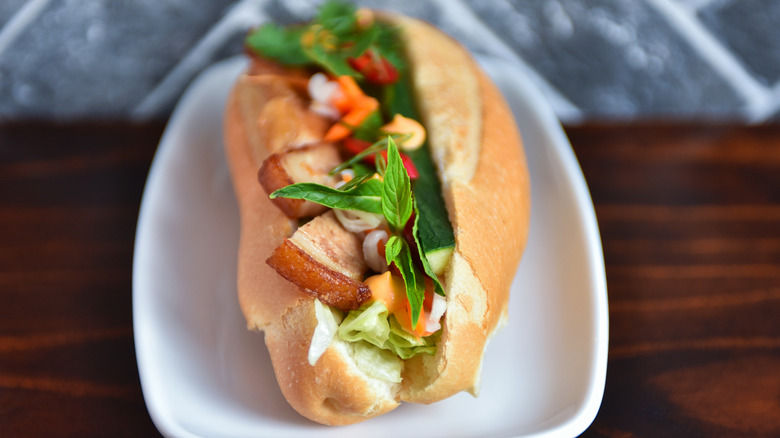12 Tips You Need When Cooking Hot Dogs
In the 1970s, General Motors released an ad campaign (rebooted in 2021) touting "baseball, hot dogs, apple pie, and Chevrolet" as unquestionable American icons. So let's talk about the iconic hot dogs. Inarguably, Americans love their hot dogs. The National Hot Dog and Sausage Council (NHDSC) reports 2022 retail sales totaled $3 billion. Other statistics from the report show sales at ballparks in 2020 reached 19.4 million dogs, and the most-hot-dog-eating city in the U.S. isn't what you'd expect it to be. Los Angeles, California, beat New York City for the most dogs consumed in 2022.
It's safe to assume that part of the hot dog's popularity is its portability and versatility. Depending on your mood, you can multitask while holding one and dress a dog up or down. To help you create the best dog you can, we enlisted the help of chef and cookbook author Kenny Gilbert of Silkies Chicken and Champagne Bar in Jacksonville, Florida, to help explain the ins and outs of dogdom.
What exactly is a hot dog?
A hot dog is technically a sausage with modifications. "Hot Dogs are an emulsified farce of meat and fat, in a natural, casing less or artificial casing while sausages are usually ground combinations of meat and fat," says Gilbert. Both start with ground beef or pork, but a hot dog, bologna, kielbasa, or other emulsified sausages undergoes further processing. A second grinding or high-speed mixing, incorporating it with ice, creates a suspension of lean meat, fat, and liquid, or the farce that Gilbert mentioned. This process gives the hotdog (or other sausages) its smooth interior texture. In short, a hot dog is a sausage with a smooth interior.
Not unpredictably, the origins of the hot dog are muddled. Germans claim them as their own, originating in Frankfurt over 500 years ago. Austrians claim the same, except the origin in their case is Vienna. Each lent its name to the sausage; frankfurter is self-explanatory, while Vienna (Wien) leads to wienerwurst or wiener. Wherever the actual story might lie, the hot dog as we know it came to America via German immigrants who popularized it as street food in New York City in the 1860s.
Pick a good dog
Now armed with the knowledge of what a hot dog is, the place to start for the best end product is with a good hot dog. Gilbert is succinct in his primary selection criteria at the store. "All-natural products," he says regarding his. Elaborating, he looks for "all beef or pork or even a combination of the two" when it comes to the meat portion of the dog, "[and] natural or no casings." Pressed for a favorite brand, Gilbert prefers Hebrew National. Why so picky?
A hotdog can contain an extensive range of ingredients, which are clearly labeled on the package, according to the National Hot Dog and Sausage Council. Aside from beef and pork, inexpensive poultry often bulks the dog. After that, you might find various stabilizers and emulsifiers like maltodextrin or modified food starch which make the texture and flavor consistent throughout the hot dog. Additives like yeast, smoke flavoring, and beef stock round out the taste of more-processed dogs. A natural casing is typically lamb or pork intestine that provides the "bite" that one often associates with a well-cooked sausage. Skinless franks get their name from removing a cellulose casing after cooking.
Select the perfect bun
Now that you have a good dog in hand, it's time to consider your bun. People have strong opinions about what a good bun might be. Some prefer the original soft-steamed bun of a New York-style hot dog like those reputedly originated by Charles Feltman. Others prefer a toasted bun. Asking our expert, "I love pretzel buns; that is my favorite. A regular soft bun works too!"
It's a personal preference, and though some say not toasting the bun is a hot dog mistake, we think both methods are right, depending on what you're looking for. The first step for either viewpoint is to find a soft bun that is still sturdy enough to hold your dog and toppings without falling apart. To steam your buns, use a small amount of water in a pan, insert a steamer basket or colander with your buns inside, and simmer them for one to two minutes. If you're not using a steamer lid that allows steam to escape, prop the lid slightly open so condensation won't drip back down on your buns. The best method to toast your buns is to apply butter or oil to the inside and toast them on your grill or in a skillet over medium heat for three to four minutes.
Preheat your dog
Hotdogs are almost always sold pre-cooked. Because of that, all you're doing when cooking a dog is heating it through and crisping the outside if your preference dictates. People will disagree, but the physics of heating a hotdog from refrigerator-cold to serving temperature on your grill or in a pan without burning it is challenging. To alleviate that, "I like to start off in dirty water, then grill or griddle [them] on the flat top," says Gilbert. Dirty water is fantastic, but we'll get to that later on. What other options are there?
You can look at the frankfurter's Wisconsin cousin, the Beer Brat. In this method, bratwurst is simmered in beer and onions before finishing in a pan or grill to give the skin that classic snappiness. Leftover pho or ramen broth can add more character, as well. The key here is simmering, not boiling. Simmering takes place below the boiling point, at around 185 degrees Fahrenheit, and is a gentler cooking method than boiling, in which the dogs can tumble around and split from heat and agitation. How long should you simmer? Around three to five minutes.
Don't fear dirty water
Unfortunate name aside, dirty water is a favorite among hot dog fans. It originated from hot dog street carts, where the dogs would sit in a pan of hot water all day, leaching their spices and fat into the water while being plumped by the heat. Dirty water is easy to create and easy to get creative with.
At its most basic, one could mash a sacrificial hot dog into a pan of simmering water and call it a day. Gilbert riffs on his dirty water, "A little chicken bouillon, bay leaf, onions, and garlic is the way to go," he says. Nothing says you can't get creative and make your unique version. Starting with the predominantly used spices in hot dogs, like paprika, onion, garlic, mace (or nutmeg), coriander, and white, black, or red pepper, and then looking at the previously suggested bay leaf and vinegar, you have a pretty good palate to start from. Nothing says you have to stick to water, either. Stock, wine, or beer can also be a good starting point.
You can stick to the classics with grilling
There are probably just as many people who'll say not to grill your dogs as there are who say that it is the correct way to cook them. Assuming you're in the latter category, read on.
After sending your dogs through one of the previously discussed frankfurter jacuzzi methods for three to five minutes to warm them without leaching their flavor, it's time to put them onto a preheated grill. Gilbert says a "charcoal grill would be my preference to get a good smokey char." Gas will also work, so fret not if you don't have a charcoal grill at your disposal. The essential steps to know are to ensure your grates are clean and you preheat your grill to medium-high heat.
Gilbert recommends placing them on a "medium-hot area of the grill and rotating them frequently to achieve the char that you desire." Hot dogs aren't to be left unattended due to their quick-burning propensity. As a matter of personal preference, some like a burnt dog, but for those who don't, as of this writing, there are no known ways to bring an over-charred hot dog back from the brink.
Pan cooking is a solid choice
For this discussion, a pan could be a skillet, flat top, griddle, plancha, or even a wok. According to Gilbert, you'll want a preheated pan over medium-high heat, which translates to about 350 degrees Fahrenheit, and you'll want your hot dogs pre-warmed using one of the methods above. It's important not to overcrowd your pan with too many dogs, as that will lower the pan's temperature, create steam, and not yield the desired crispness. So, work with three to four hotdogs at a time, and rotate the dogs frequently, every 30 to 60 seconds to brown them on all sides.
You could also take a variation of the beer brat bath and start with beer (or wine) and onions in the pan, boiling them until the volume has reduced by ¾. Add your dogs to the pan and allow them to warm through in the beer. When the beer completely evaporates, the hot dogs will begin to brown in the pan while the onions continue cooking. Snappy-skinned hot dogs and beer-roasted onions in one shot aren't too bad.
Deep-fried hot dogs are always winners
In 1928, Royal "Abe" and Ann Fedorchak Rutt opened Rutt's Hut Clifton, New Jersey, serving deep-fried "ripper" dogs, so named because the hot dogs would twist and rip during the frying process, crisping the outside as well as some of the inside. To some, this method is off the table, but we've got you if you're feeling intrigued or nostalgic.
A necessary safety precaution from the FDA; liquid and hot fat don't play well together. To avoid a fryer boilover and subsequent injuries, do not simmer your hot dogs before frying them.
If you have a deep fryer, heat it to 375 degrees Fahrenheit. Lacking a deep fryer, you can fill a pot or Dutch oven with 3 inches of oil and slowly heat it, checking the temperature with a candy thermometer. Doing this over low heat will minimize your chances of overshooting your target temperature. Add the hot dogs in batches so as not to overcrowd the pot and lower the temperature, and cook them for three to four minutes until the skin rips open. You can cook them longer to reach your desired level of doneness.
Air frying your dog is a unique option
Deep frying your hot dogs can be a messy and possibly dangerous proposition. Pan-frying them can lead to grease splatters on your stove, countertops, and walls; sometimes, the weather won't cooperate with grilling. Outside of simmering them, which is a perfectly acceptable cooking method, what's left if you want more texture for your hot dog? If you have the means at your disposal, you can try the mess-free cooking method for easy hot dogs: air frying.
The process is simple; preheat your air fryer to 375 degrees Fahrenheit and then arrange your hot dogs on the air fryer grate or basket in a single layer. Try to avoid having the dogs touch each other when doing this, as those parts won't brown as well as the rest of the sausage. Air fry your hot dogs for five minutes, turning them over halfway through cooking. The resulting texture of a dry-cooked (rather than simmered) dog without the mess or hassle of pans, pots, and grills might be your style.
Mix up your toppings
Part of the fun of the hot dog experience is their versatility and how you choose to garnish them. You can be a bare-bones traditionalist or veer into specialty land. Gilbert skews towards the former, "mustard and onions for me. I like kraut as well. A Chicago Dog is delicious as well," he says.
The beauty of this simplistic approach is that there are many levels within each ingredient family. Mustard could be classic yellow, Creole, multiple variations of European mustard, or Chinese hot mustard. Cabbage plays well in multiple forms, too. Sauerkraut, cole slaw (Gilbert recommends vinegar-based over mayonnaise), or kimchi are just a few ways to bring it to the table.
Regional hot dog variations are numerous and range from familiar to very much unfamiliar. Outside of the iconic New York style, the most recognizable is probably the Chicago Dog with pickles, peppers, tomatoes, celery salt, onions, and relish. Sonoran dogs are bacon-wrapped and finished with refried beans, chiles, onions, cheese, tomatillo salsa, mayonnaise, and mustard. A Seattle dog pulls ingredients from all over, sporting cream cheese, jalapeños, grilled onions, and Sriracha. These are just a few samples of hyper-local styles worth investigating to expand your options.
But keep the toppings balanced
You've got your dog on a bun and are facing a counter full of sauces, pickles, and other condiments. What comes next determines the success of your hot dog experience. Try to find ingredient combinations that will accent or contrast your dog. Building the perfect hot dog toppings is like anything else. You'll want to add something acidic to your dog to balance the fatty richness, and possibly a crunch like a cole slaw or kimchi we've mentioned, or go with something deep-fried to fill that niche. And something creamy, like a mustard sauce, mayonnaise-based sauce, or even melted cheese, binds flavors and provides a liquid buffer for your bun, keeping it from getting soggy.
With that in mind, here's something you might take exception to; just because a little bit of an ingredient is good doesn't mean a lot is. Even a Chicago Dog, with its numerous elements, shows restraint in the amounts used. We've all made the "perfect" taco, only to pick it up and have it explode because we put too much inside the tortilla. Don't do the same with your hot dog.
Expand your global hot dog horizons
While Americans' love for hot dogs is unquestionable, the U.S. doesn't have the corner on Frankfurter fandom. Taking a peek at how hot dog lovers around the world approach their versions can kickstart new ideas in your kitchen or backyard.
In Sweden, Swedish-style hot dogs called tunnbrödsrulle are a popular street food in larger cities, where hot dogs share space in a specialized thin bread stuffed with mashed potatoes and finished with crispy onions, sweet pickle relish, mustard, mayo, ketchup, and sometimes shrimp salad. Currywurst (which has a post-war origin story), is probably the best-known German iteration of a hot dog, mixing ketchup and curry powder as a topping, sometimes served sliced, others times on a bun.
Guatemalan shucos pair dogs with onions and peppers, ketchup and mustard, mayonnaise, boiled cabbage or sauerkraut, sometimes ham or bacon, and guacamole on a special bun. Replace the bun with a tortilla, and it's known as a mixto. In Taiwan, a Da Chang Bao Xiao Chang (Small Sausage Wrapped in Large Sausage) is a pork sausage inside a bun-like construction of grilled sticky rice. From there, the "hot dog" is commonly topped with garlic, chile sauce, sweet soy, ginger, and some pickled vegetables.
Static Media owns and operates Tasting Table and Mashed.
